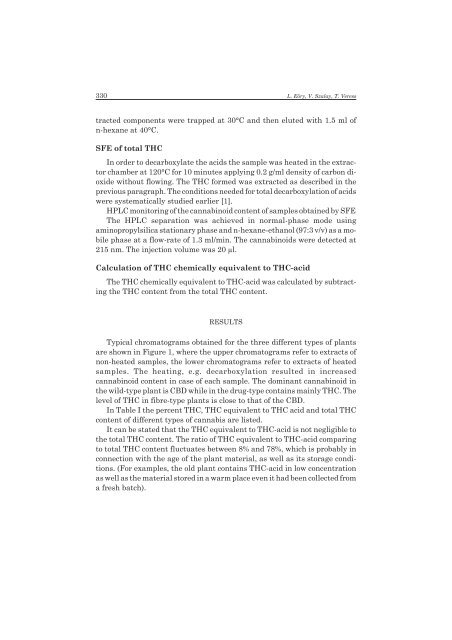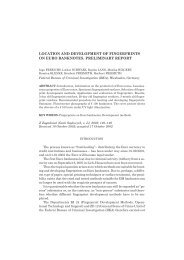supercritical fluid extraction of tetrahydrocannabinol from marihuana ...
supercritical fluid extraction of tetrahydrocannabinol from marihuana ...
supercritical fluid extraction of tetrahydrocannabinol from marihuana ...
You also want an ePaper? Increase the reach of your titles
YUMPU automatically turns print PDFs into web optimized ePapers that Google loves.
330 L. Eöry, V. Szalay, T. Veress<br />
tracted components were trapped at 30°C and then eluted with 1.5 ml <strong>of</strong><br />
n-hexane at 40°C.<br />
SFE <strong>of</strong> total THC<br />
In order to decarboxylate the acids the sample was heated in the extractor<br />
chamber at 120°C for 10 minutes applying 0.2 g/ml density <strong>of</strong> carbon dioxide<br />
without flowing. The THC formed was extracted as described in the<br />
previous paragraph. The conditions needed for total decarboxylation <strong>of</strong> acids<br />
were systematically studied earlier [1].<br />
HPLC monitoring <strong>of</strong> the cannabinoid content <strong>of</strong> samples obtained by SFE<br />
The HPLC separation was achieved in normal-phase mode using<br />
aminopropylsilica stationary phase and n-hexane-ethanol (97:3 v/v) as a mobile<br />
phase at a flow-rate <strong>of</strong> 1.3 ml/min. The cannabinoids were detected at<br />
215 nm. The injection volume was 20 µl.<br />
Calculation <strong>of</strong> THC chemically equivalent to THC-acid<br />
The THC chemically equivalent to THC-acid was calculated by subtracting<br />
the THC content <strong>from</strong> the total THC content.<br />
RESULTS<br />
Typical chromatograms obtained for the three different types <strong>of</strong> plants<br />
are shown in Figure 1, where the upper chromatograms refer to extracts <strong>of</strong><br />
non-heated samples, the lower chromatograms refer to extracts <strong>of</strong> heated<br />
samples. The heating, e.g. decarboxylation resulted in increased<br />
cannabinoid content in case <strong>of</strong> each sample. The dominant cannabinoid in<br />
the wild-type plant is CBD while in the drug-type contains mainly THC. The<br />
level <strong>of</strong> THC in fibre-type plants is close to that <strong>of</strong> the CBD.<br />
In Table I the percent THC, THC equivalent to THC acid and total THC<br />
content <strong>of</strong> different types <strong>of</strong> cannabis are listed.<br />
It can be stated that the THC equivalent to THC-acid is not negligible to<br />
the total THC content. The ratio <strong>of</strong> THC equivalent to THC-acid comparing<br />
to total THC content fluctuates between 8% and 78%, which is probably in<br />
connection with the age <strong>of</strong> the plant material, as well as its storage conditions.<br />
(For examples, the old plant contains THC-acid in low concentration<br />
as well as the material stored in a warm place even it had been collected <strong>from</strong><br />
a fresh batch).
















